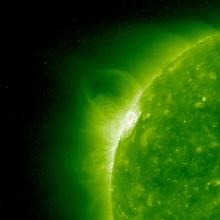CME and Radio Burst (May 8, 2009)

Hi-res TIF image (1.4M)
MPEG Movie:
Large (4.0M)
Quicktime Movie:
EUV 195 Large (3.3M),
Small (2.1M)
COR2 Large (2.7M),
Small (1.6M)
STEREO (Behind) spacecraft observed a substantial coronal mass ejection (CME) that was ejected into space (May 5, 2009). The force of the CME also generated a large Type II radio burst, the first one observed in over a year. The COR-2 coronagraph video clip captured the action in frames taken about every 30 minutes over about one day. The source of the CME is an active region (seen as a bright area in the green EUV 195 still) just rotating into view from STEREO Behind, and it is being followed by another.
(CMEs are large solar storms that blast a billion tons of particles into space at millions of miles per hour.) The burst can be clearly seen erupting in the EUV 195 still frame and movie. When the burst occurred, the active regions were still behind the limb of the Sun as seen from Earth. Because of its unique position behind Earth's orbit, the Behind spacecraft is able to spot and track these regions on the Sun before anyone else can, providing important information for space weather forecasters.
SOHO began its Weekly Pick some time after sending a weekly image or video clip to the American Museum of Natural History (Rose Center) in New York City. There, the SOHO Weekly Pick is displayed with some annotations on a large plasma display.
If your institution would also like to receive the same Weekly Pick from us for display (usually in Photoshop or QuickTime format), please send your inquiry to steele.hill@gsfc.nasa.gov.


